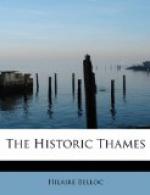The upper part of the river, which is in lowland valleys the most easily inhabited, and the part in which, once the river is navigable, will be found the largest number of small settlements, is in the case of the Thames the most marshy. From its source to beyond Cricklade the river runs entirely over clay; thenceforward the valley is a flat mass of alluvium, in which the stream swings from one side to the other, and even where it touches higher soil, touches nothing better than the continuation of this clay. In spite, therefore, of the shallowness and narrowness of the upper river there always existed this impediment which an insecure soil would present to the formation of any considerable settlements. The loneliness of the stretch below Kelmscott is due to an original difficulty of this kind, and the one considerable settlement upon the upper river at Lechlade stands upon the only place where firm ground approaches the bank of the river.
This formation endures well below Oxford until one reaches the gap at Sandford, where the stream passes between two beds of gravel which very nearly approach either bank.
Above this point the Thames is everywhere, upon one side or the other, guarded by flat river meadows, which must in early times have been morass; and nowhere were these more difficult of passage than in the last network of streams between Witham Hill and Sandford, to the west of the gravel bank upon which Oxford is built.
Below Sandford, and on all the way to London Bridge, the character of the river in this respect changes. You have everywhere gravel or flinty chalk, with but a narrow bed of alluvial soil, upon either bank to represent the original overflow of the river.
At the crossing places (as we shall see later), notably at Long Wittenham, at Wallingford, at Streatley, at Pangbourne, and, still lower, at Maidenhead and at Ealing, this hard soil came right down to the bank upon either side.
On all this lower half of the Thames marsh was rare, and was to be found even in early times only in isolated patches, which are still clearly defined. These are never found facing each other upon opposite banks of the stream. Thus there was a bad bit on the left bank above Abingdon, but the large marsh below Abingdon, where the Ock came in, was on the right bank, with firm soil opposite it. There was a large bay, as it were, of drowned land on the right bank, from below Reading to a point opposite Shiplake, the last wide morass before the marshes of the tidal portion of the river; and another at the mouth of the Coln, above Staines, on the left bank, which was the last before one came to the mud of the tidal estuary; and even the tidal marshes were fairly firm above London. From Staines eastward down as far as Chelsea the superficial soil upon either side is of gravels, and the long list of ancient inhabited sites upon either bank show how little the overflow of the river interfered with its usefulness to men.




